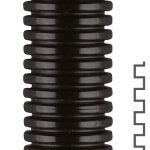
Cable glands are a valuable piece of equipment that provide a long-lasting and secure connection between a cable and a device. Different cable gland types are common across industries, and they’re available in various sizes and materials. Use this complete guide to learn how to find the right cable gland and cable gland size for your specific needs.

Table of Contents
Cable Gland Size Chart
A cable gland size is dependent on the overall diameter’s nominal dimensions, the armor diameter and the thickness of the cable. Cable gland size charts make it easy to find your application’s cable gland size. This chart acts as a cable gland size calculator. The cable cross-section area (mm²) is represented in the rows, while the number of cores in the cable are listed in the columns.
When using the chart, first find your cable size listed in the rows, then find your number of cable cores in the column. Find the intersecting point on the table where these two numbers meet, and you’ll see what cable gland size is best suited for your needs.
Cable sizes can range from 1.5 mm² to 1000 mm², and the number of cores can range from one to 48. Even with this wide range, cable gland size charts make it easy to find any application’s corresponding cable gland size. For example, say your cable size comes to 10 mm², and your number of cores is four. Using the chart, we see the intersecting point for these two variables is 25, meaning the correct cable gland size for your needs is 25.
On the cable gland size chart, you may also notice some numbers are followed by an “S,” for example, 20S. This letter indicates the inner assembly locking thread will be a small size. This thread size indicator helps you ensure you’ve picked the correct cable gland size and type. You can always check with a professional team like the experts at AerosUSA if you’re still unsure about the correct cable gland size for you.

How to Measure Cable Glands
With so many options available, you may wonder how to choose a cable gland size to ensure you purchase the correct size. The first tip is to always aim to use cable glands from the same manufacturer as the overall system, as this allows for maximum efficiency and performance.
When you use products from the same manufacturer, finding the correct cable gland should be relatively easy, as the manufacturer should supply a table that outlines any specifications or conversions needed to measure the cable gland. This chart will make it easy to properly measure and determine the proper cable gland size.
When measuring for a cable gland, you must first identify the type of cable being used. Determine if the cable is armored or unarmored. The distinction between cables is crucial, as each type requires a different cable gland size. Unarmored cables are fairly simple to measure. The most important measurement for unarmored cables is the diameter of the cable.
Meanwhile, armored cables require a few more measurements and considerations. Some of these considerations include the:
- Diameter of the inner bedding.
- Diameter of the cable’s armoring.
- Diameter of the lead covering.
- Size and type of the armor or braid.
- Type and material of the cable armor.
- Short circuit fault current rating.
The various armored cable measurements work together to determine the correct cable gland size. When working with cables with threading, you need to know the gauge in order to determine the perfect cable gland size. In some cases, the outer cable sheath and sometimes the armoring will need to be removed in order to create a perfect fit. If armoring does require removal, you’ll want to determine this during the planning phases of the network.
A few other key elements to look for when measuring for a cable gland include:
- The materials used in producing the cable
- Earth tags
- Entry head seals
- Shrouds
- Additional accessories, such as lock nuts and washers
- Determine if stopper plugs or reducers are needed
How to Check You Have the Correct Cable Gland Size
Once you’ve measured and determined the proper cable gland size for your needs, it’s a good idea to double-check your work. Use the following questions to guide your thinking and verify you have selected the correct cable gland size:
- Will the cable gland’s diameter properly accommodate all of the cables in the system?
- Does the gland size have the correct pressure rating needed for your application?
- Is the diameter of the gland mounting hold big enough for your cable gland?
- Is the cable gland depth and size PG or metric?
Professionals, like the expert team at AreosUSA, can also help verify the correct cable size if you’d like further assistance.
How to Choose a Cable Gland
Choosing a cable gland is not as simple as just choosing the correct size. While finding the correct size is a critical component, there are other factors to consider when it comes to choosing a cable gland, such as:
- Purpose: Will the cable gland be used for a domestic, commercial or industrial application? This can impact the cable gland material or type you choose.
- Location: Another key consideration is the location of the cable gland. Will the cable gland be indoors or outdoors? Also, will the location of the cable gland potentially expose it to dirt, dust or other corrosive elements?
- Temperature: In addition to the location of the cable gland, consider the temperature in the area. Will the cable gland be exposed to extreme temperatures, and will these temperatures fluctuate?
- Atmosphere: Also consider the overall atmosphere. Will the cable gland be in an area with explosive or corrosive elements? What precautions will you need to take to preserve the cable gland’s integrity?
With these questions in mind, you can narrow down the type of cable gland that is suitable for your application.
Shop Our Selection of Cable Glands
Cable glands are a vital piece of equipment across various industries, so it’s crucial to take your time finding the perfect, high-quality cable gland. At AerosUSA, we’re proud to be the leading supplier of cable and wire protection systems. Our cable glands are extremely high-quality to ensure our clients can maximize their system’s safety and productivity.
In addition to cable glands, we offer a variety of products suitable for multiple industries such as marine, power, aerospace, industrial and telecom sectors. Contact our AerosUSA team today to learn more about how our high-quality products, fast responses and quick turnaround times can benefit your business.





